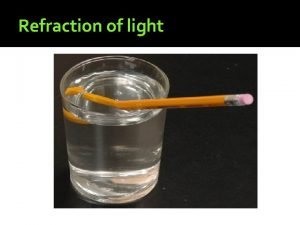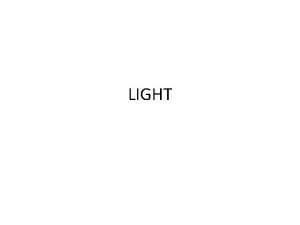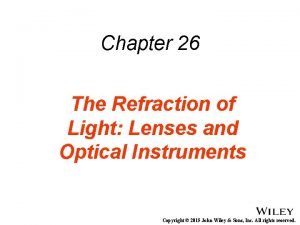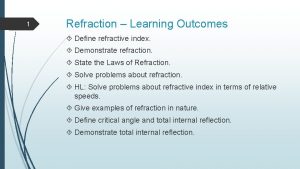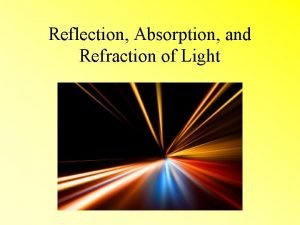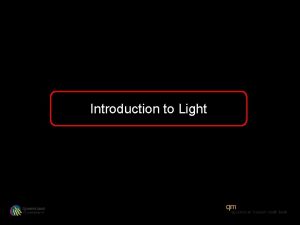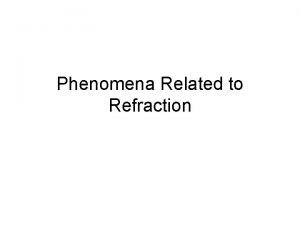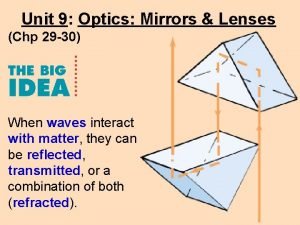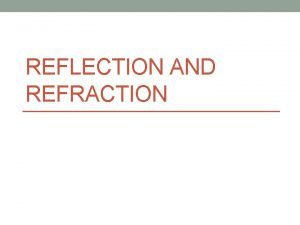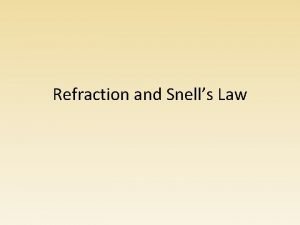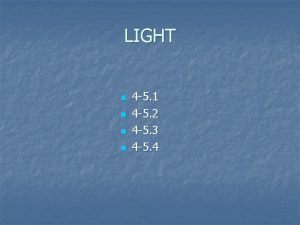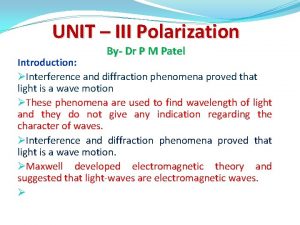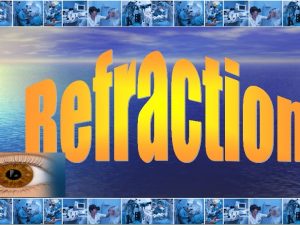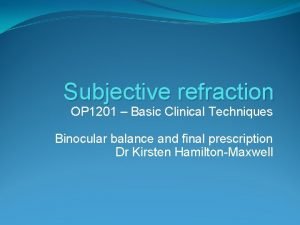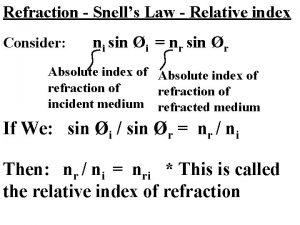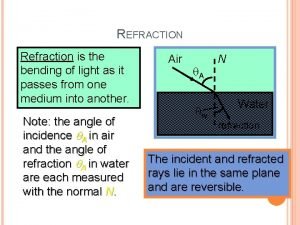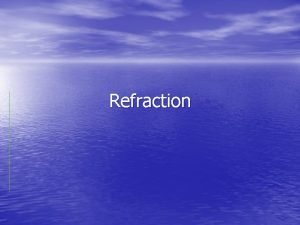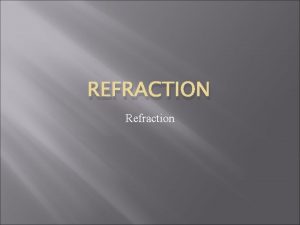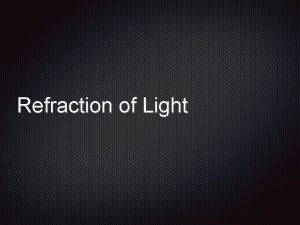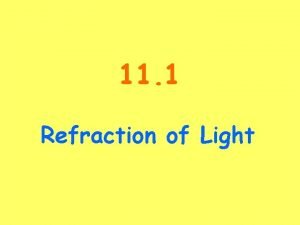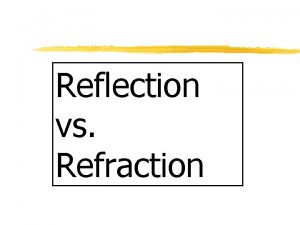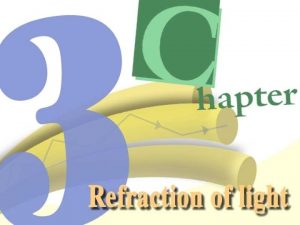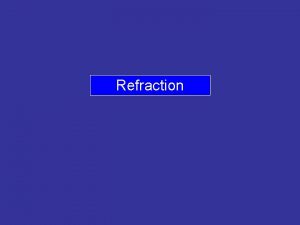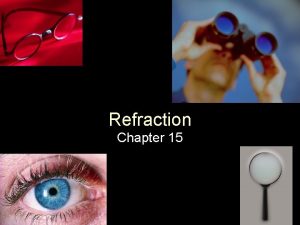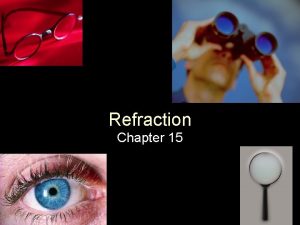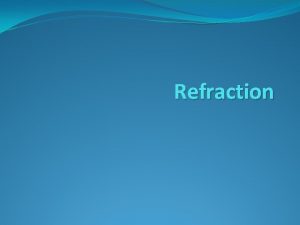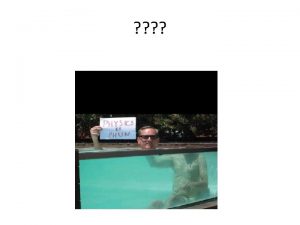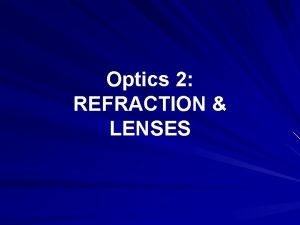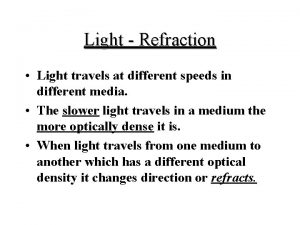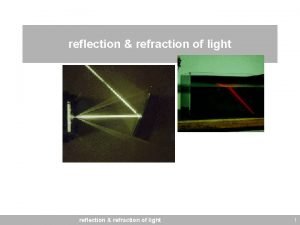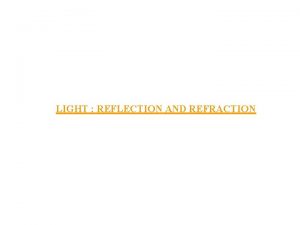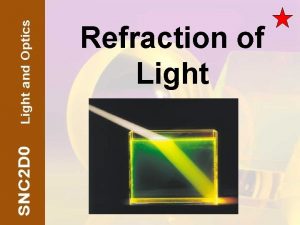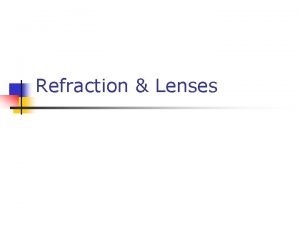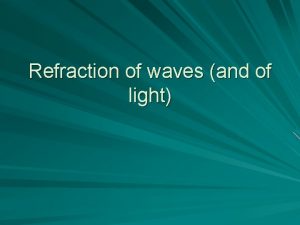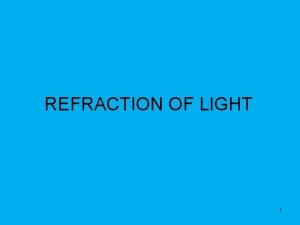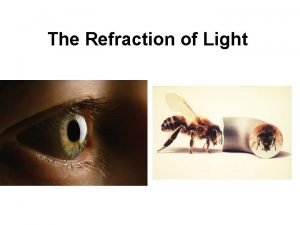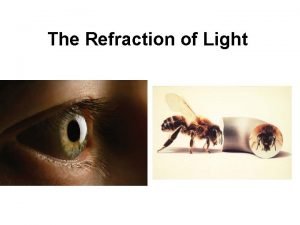Refraction of light Cause of Refraction In different









































- Slides: 41

Refraction of light

Cause of Refraction �In different mediums, - Optical density is different, -so speed of light is different Greater optical density, lesser speed of light

Refraction from air(rarer) to glass (denser) medium

Refraction from denser to rarer medium

Refraction at normal incidence


Laws of Refraction The incident ray, the refracted ray and the normal at the point of incidence, all lie in the same plane.

Refractive Index For two particular media, the ratio of the sine of the angle of incidence to the sine of the angle of refraction is a constant(Snell`s law).

Speed and Refractive Index Speed of light in vacuum = 3 x 108 ms-1 Light is found to move slower in optically denser mediums. (eg. glass and water)

Properties affected due to refraction Property Air to Glass to Air Frequency Remains constant Speed Decreases Increases Wavelength Decreases Increases Direction Towards normal Away from normal

Factors affecting RI 1. Nature of material Greater the speed, lesser the RI 2. Wavelength (colour) of light Greater the wavelength, lesser the RI 3. Temperature of material Greater the temperature, lesser the RI

Lateral Displacement The perpendicular distance between the path of incident ray and emergent ray is called lateral displacement.

Factors affecting Lateral displacement 1. The thickness of the glass 2. The angle of incidence 3. The refractive index of glass 4. Wavelength/frequency of incident ray

Principle Of Reversibility The principle of reversibility of light states that the path of a ray of light is reversible. According to this principle , if a ray of light travels from A to B along a certain path, it will follow exactly the same path, while travelling from B to A

am g represents refractive index of glass with respect to air then Similarly if refraction occurs from denser to rarer medium or The above expression is an important result of the principle of reversibility of light which states that when a ray of light after suffering a large number of reflections and refractions has its final path reversed, it travels back along the same path in the opposite direction as shown above.

Real and Apparent Depth Consider a ray of light incident on XY, normally along OA, it passes straight along OAA l. Consider another ray from O (the object) incident at an angle i on XY, along OB. This ray gets refracted and passes along BC. On producing this ray BC backwards, it appears to come from the point I and hence AI represents the apparent depth, which is less than the real depth AO. ∟AOB = ∟OBN= i ( alternating angles) B When angles are small, B lies close to A such that OB ~ OA IB ~ AI

Apparent position and twinkling of stars The atmosphere consists of a number of parallel layers of different densities. Varying temperature and pressure account for the different densities. As the rays enter in layers of increasing densities they are being continuously refracted. In the process, the rays follow a curved path and reach the observer. But due to the wind and convection currents, the density of the layers go on changing. Therefore, after very short intervals of time, the position of the image of the star keeps changing , and produces the twinkling effect

Apparent sunrise/sunset Due to atmospheric refraction, sunrise occurs shortly before the sun crosses above the horizon. Light from the sun is bent, or refracted, as it enters earth's atmosphere. This effect causes the apparent sunrise to be earlier than the actual sunrise. Similarly, apparent sunset occurs slightly later than actual sunset. The sunrise and sunset times reported in our calculator have been corrected for the approximate effects of atmospheric refraction. However, it should be noted that due to changes in air pressure, relative humidity, and other quantities, we cannot predict the exact effects of atmospheric refraction on sunrise and sunset time. Also note that this possible error increases with higher (closer to the poles) latitudes.

Spear Fishing Spear fishermen use a strange trick to catch their prey. They aim at a point slightly below where the fish seems to be. The reason is that light changes direction when it moves from one transparent substance, such as water, to another of different density, such as air. This change of direction is called REFRACTION.

Bending of stick in water A stick immersed in water appears bent and short at the surface of water when viewed obliquely from above. This is because the rays of light travel from water to air and bend away from the normal at the surface

A coin appears raised in water B A Place a coin A at the bottom of an empty vessel. The position of the eye is so adjusted that the coin cannot be seen. Now slowly fill the vessel with water and maintain a steady gaze at the coin. The coin gradually begins to appear. Thus, B is the raised , apparent position of the coin A due to refraction of light

Multiple images in a Thick Glass Plane Mirror

Total Internal Reflection As the angle of incidence increases, the angle of refraction increases


Critical Angle Critical angle is the angle at which the refracted o ray is at 90


Conditions for TIR The ray must travel from denser medium to rarer medium. The angle of incidence i must be greater than critical angle C

Distinction between total reflection and reflection from a plane mirror Total internal reflection Reflection from a plane mirror � � It takes place when light passes from a denser medium to a rare medium when angle of incidence is greater than the critical angle � The entire light is reflected � There is no loss of energy � The image is much brighter and the brightness is permanent It takes place when light is incident on a plane mirror from any medium at any angle of incidence � Only part of light is reflected while rest is refracted and absorbed. � The energy of reflected ray is less than that of the incident ray � The image is less bright and the brightness gradually decreases.

Total internal reflection in a Prism This action of prism is used in a periscope A periscope may be used by people (i) in a submarine to see above the sea surface (ii) to see over the heads of people in a crowd.

Deviation through 180 degree This action of prism is used in binocular

Erecting Prism This action of prism is used in a slide projector

Deviation through 60 degree by an Equilateral Prism

Total internal reflection and refraction of light through 30◦ , 90◦, 60◦Prism No total internal reflection Total internal reflection takes place

Consequences of total internal reflection TIR in Diamonds Sparkling is due to: 1. Cut of diamond faces 2. High index of refraction which means a very small critical angle (n = 2. 42, C = 24. 4°) Incident rays can undergo multiple TIR inside a diamond before exiting the top of the diamond.

REFRACTION THROUGH A PRISM

PRISM A prism is a transparent refracting medium Bounded by two plane surfaces making an angle with each other.

PRINCIPAL SECTION OF THE PRISM A REFRCTING ANGLE RE F SU RAC RF T AC ING E ING CT FRA E RE FAC R SU B BASE The section of the prism perpendicular to the refracting edge is called the principal section of prism. the refracting edge is. C called the principal section of

DEVIATION BY A PRISM

Dependence of angle of deviation on the angle of incidence i- curve ᵟ minimum deviation. When the angle of incidence is increased further, the angle of deviation now starts increasing.

Relation between angle of incidence, angle of prism, angle of deviation and angle of emergence A + δ = i + e

Factors affecting the angle of deviation 1. The angle of incidence 2. The material of the prism 3. The angle of the prism 4. The colour or wavelength of light used.
 Lateral displacement formula
Lateral displacement formula Light light light chapter 23
Light light light chapter 23 Light light light chapter 22
Light light light chapter 22 Chapter 22
Chapter 22 Concave vs convex light refraction
Concave vs convex light refraction Refraction of light in lenses
Refraction of light in lenses Laws of refraction
Laws of refraction Reflection refraction absorption transmission
Reflection refraction absorption transmission Introduction of light
Introduction of light Phenomena related to refraction
Phenomena related to refraction Refraction of light
Refraction of light When a wave reaches a boundary it
When a wave reaches a boundary it Refraction of light
Refraction of light Light refraction
Light refraction Practice noise, light, and litter discipline scenarios
Practice noise, light, and litter discipline scenarios Ter thin client
Ter thin client Greylag goose egg-retrieval behavior
Greylag goose egg-retrieval behavior Proximate cause and ultimate cause
Proximate cause and ultimate cause Imprinting example
Imprinting example Thermosoftening plastics examples
Thermosoftening plastics examples Flame test principle
Flame test principle Sound will travel at different speeds in different mediums.
Sound will travel at different speeds in different mediums. Sound travels fastest through
Sound travels fastest through Cultural relarivism
Cultural relarivism Different angle different story
Different angle different story Different faces song
Different faces song Different materials have different
Different materials have different Different people different things
Different people different things Argumenterande tal struktur
Argumenterande tal struktur Properties of light
Properties of light Transparent material example
Transparent material example Who says put out the light and then put out the light
Who says put out the light and then put out the light Distinguish between photosystem 1 and photosystem 2
Distinguish between photosystem 1 and photosystem 2 The bouncing off of light.
The bouncing off of light. Which materials let light through
Which materials let light through Vray refraction ior
Vray refraction ior The obtuse angle in principal planes of calcite crystal is
The obtuse angle in principal planes of calcite crystal is Clinical classification of myopia
Clinical classification of myopia Fogging technique in refraction
Fogging technique in refraction Index of refraction
Index of refraction What is bending of light
What is bending of light Critical.angle formula
Critical.angle formula
